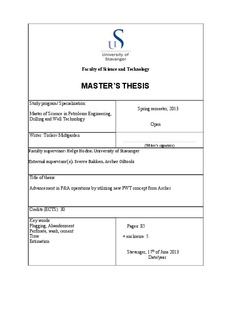| dc.contributor.author | Midtgarden, Torleiv | |
| dc.date.accessioned | 2013-11-12T14:36:25Z | |
| dc.date.available | 2013-11-12T14:36:25Z | |
| dc.date.issued | 2013-06-17 | |
| dc.identifier.uri | http://hdl.handle.net/11250/183542 | |
| dc.description | Master's thesis in Petroleum engineering | no_NO |
| dc.description.abstract | Many of the oil and gas fields on the Norwegian continental shelf (NCS) are approaching the end of field life. The Petroleum safety authority of Norway is putting pressure on the Exploration and Production (E&P) companies and demanding final field permanent plug and abandonment of several fields within a short period of time. Especially the temporary plugged and abandoned wells [1]. Over the next 5 to 25 years, several thousand wells will need to be plugged and abandoned on the NCS [2].
The conventional method for Plug and abandonment (P&A) includes casing removal by milling operations in order to access the formation for barrier placement. This conventional P&A activity is considered by E&P companies as time consuming, costly and causes additional risks related to health, safety and environment (HSE). Thus a growing interest has been put into finding new methods and solutions to reduce the time and cost of such operations. Archer recognizes this need, and has put effort in developing new intelligent concepts and technical solutions to overcome these challenges. As a result, the Perforate and Wash Tool (PWT) has been introduced.
The PWT tool is designed to perforate a selected casing or liner section, wash and clean the perforated section completely, prior to placing a cross sectional cement plug. By eliminating the need for section milling and debris handling, and preparing the seal zone to receive cement, the PWT concept delivers a step change in P&A efficiency and effectiveness. Over the last years this PWT concept has been improved to increase efficiency of the P&A operation. Recently a new technique has been developed for cement placement in the perforated interval to form a permanent P&A barrier. By applying this newest cementing technique, the time to perform the whole plug placement sequence can be reduced significantly.
This thesis has examined and present Archers PWT tool and investigated its advancement in the P&A operation. A case study comparing the conventional P&A method of section milling with the PWT concept has been performed. The case compare the methods with respect to time and scope for placing P&A plugs in a production well in the Ekofisk field offshore Norway.
The main findings from the case study revealed a potential for significant timesaving by utilizing the PWT methods compared to section milling operations. By applying the new PWT technique the operational time to place P&A barriers in the production well was reduced by 70%. Considering the amount of wells that are to be plugged the coming years, and the limited availability of rigs, saving time on P&A operations will be crucial for the E&P companies. | no_NO |
| dc.language.iso | eng | no_NO |
| dc.publisher | University of Stavanger, Norway | no_NO |
| dc.relation.ispartofseries | Masteroppgave/UIS-TN-IPT/2013; | |
| dc.subject | petroleumsteknologi | no_NO |
| dc.subject | boreteknologi | no_NO |
| dc.subject | plug and abandonment | no_NO |
| dc.subject | P&A | no_NO |
| dc.title | Advancement of P&A operations by utilizing new PWT concept from Archer | no_NO |
| dc.type | Master thesis | no_NO |
| dc.subject.nsi | VDP::Technology: 500::Rock and petroleum disciplines: 510::Petroleum engineering: 512 | no_NO |
